Muchirigathiru1
On this page, you find all documents, package deals, and flashcards offered by seller muchirigathiru1.
- 2716
- 0
- 0
Community
- Followers
- Following
2716 items
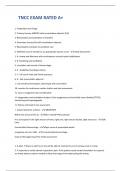
TNCC EXAM RATED A+
1. Preparation and Triage 2. Primary Survery (ABCDE) with resuscitation adjuncts (F,G) 3. Reevaluation (consideration of transfer) 4. Secondary Survey (HI) with reevaluation adjuncts 5. Reevaluation and post resuscitation care 6. Definitive care of transfer to an appropriate trauma nurse - Initial Assessment 1. A- airway and Alertness with simultaneous cervical spinal stabilization 2. B- breathing and Ventilation 3. circulation and control of hemorrhage 4. D - disability (neurologic sta...
- Exam (elaborations)
- • 10 pages •
1. Preparation and Triage 2. Primary Survery (ABCDE) with resuscitation adjuncts (F,G) 3. Reevaluation (consideration of transfer) 4. Secondary Survey (HI) with reevaluation adjuncts 5. Reevaluation and post resuscitation care 6. Definitive care of transfer to an appropriate trauma nurse - Initial Assessment 1. A- airway and Alertness with simultaneous cervical spinal stabilization 2. B- breathing and Ventilation 3. circulation and control of hemorrhage 4. D - disability (neurologic sta...
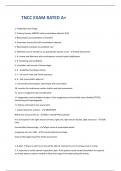
TNCC EXAM RATED A+
1. Preparation and Triage 2. Primary Survery (ABCDE) with resuscitation adjuncts (F,G) 3. Reevaluation (consideration of transfer) 4. Secondary Survey (HI) with reevaluation adjuncts 5. Reevaluation and post resuscitation care 6. Definitive care of transfer to an appropriate trauma nurse - Initial Assessment 1. A- airway and Alertness with simultaneous cervical spinal stabilization 2. B- breathing and Ventilation 3. circulation and control of hemorrhage 4. D - disability (neurologic sta...
- Exam (elaborations)
- • 10 pages •
1. Preparation and Triage 2. Primary Survery (ABCDE) with resuscitation adjuncts (F,G) 3. Reevaluation (consideration of transfer) 4. Secondary Survey (HI) with reevaluation adjuncts 5. Reevaluation and post resuscitation care 6. Definitive care of transfer to an appropriate trauma nurse - Initial Assessment 1. A- airway and Alertness with simultaneous cervical spinal stabilization 2. B- breathing and Ventilation 3. circulation and control of hemorrhage 4. D - disability (neurologic sta...
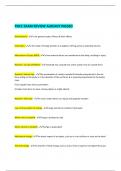
TNCC EXAM REVIEW ALREADY PASSED
Biomechanics - Is the general study of forces & their effects Kinematics - Is the study of energy transfer as it applies to ID'ing actual or potential injuries Mechanism of Injury (MOI) - Is how external forces are transferred to the body, resulting in injury Newton's 1st Law of Motion - A body @ rest, stays @ rest unless acted on by an outside force Newton's Second Law - The acceleration of a body is parallel & directly proportional to the net force acting on the body, is in the directi...
- Exam (elaborations)
- • 8 pages •
Biomechanics - Is the general study of forces & their effects Kinematics - Is the study of energy transfer as it applies to ID'ing actual or potential injuries Mechanism of Injury (MOI) - Is how external forces are transferred to the body, resulting in injury Newton's 1st Law of Motion - A body @ rest, stays @ rest unless acted on by an outside force Newton's Second Law - The acceleration of a body is parallel & directly proportional to the net force acting on the body, is in the directi...
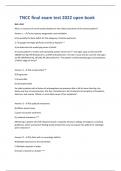
TNCC final exam test 2022 open book
Get a hint Why is a measure of serum lactate obtained in the initial assessment of the trauma patient? Answer: c - a) to measure oxygenation and ventilation b) to quantify the base deficit for the adequacy of cellular perfusion c) *to gauge end-organ perfusion and tissue hypoxia ** d) to determine the underlying cause of shock A trauma patient is restless and repeatedly asking "where am I?" vital signs upon arrival were BP 100/60 mm Hg, HR 96 beats/min, and RR 24 breaths/min. Her skin i...
- Exam (elaborations)
- • 13 pages •
Get a hint Why is a measure of serum lactate obtained in the initial assessment of the trauma patient? Answer: c - a) to measure oxygenation and ventilation b) to quantify the base deficit for the adequacy of cellular perfusion c) *to gauge end-organ perfusion and tissue hypoxia ** d) to determine the underlying cause of shock A trauma patient is restless and repeatedly asking "where am I?" vital signs upon arrival were BP 100/60 mm Hg, HR 96 beats/min, and RR 24 breaths/min. Her skin i...
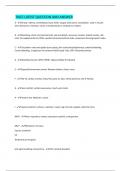
TNCC LATEST QUESTION AND ANSWER
A - Airway--edema, vomit/blood, loose teeth, tongue obstruction, vocalization. Look in mouth, clear all/suction, maintain c-spine, cricothyrotomy or intubate as needed. B - Breathing--chest rise (symmetrical), rate and depth, accessory muscles, breath sounds, skin color. Do supplemental o2, BVM, needle thoracentesis/chest tube, nonporous dressing taped 3 sides. C - Circulation--rate and quality (core pulse), skin color/temp/diaphoresis, external bleeding. Control bleeding, 2 large bore IVs ...
- Exam (elaborations)
- • 3 pages •
A - Airway--edema, vomit/blood, loose teeth, tongue obstruction, vocalization. Look in mouth, clear all/suction, maintain c-spine, cricothyrotomy or intubate as needed. B - Breathing--chest rise (symmetrical), rate and depth, accessory muscles, breath sounds, skin color. Do supplemental o2, BVM, needle thoracentesis/chest tube, nonporous dressing taped 3 sides. C - Circulation--rate and quality (core pulse), skin color/temp/diaphoresis, external bleeding. Control bleeding, 2 large bore IVs ...
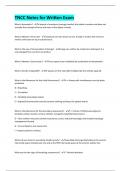
TNCC Notes for Written Exam
What is kinematics? - A branch of mechanics (energy transfer) that refers to motion and does not consider the concepts of force and mass of the object or body. What is Newton's First Law? - A body at rest will remain at rest. A body in motion will remain in motion until acted on by an outside force. What is the Law of Conservation of Energy? - Energy can neither be created nor destroyed. It is only changed from one form to another. What is Newton's Second Law? - Force equals mass multipl...
- Exam (elaborations)
- • 30 pages •
What is kinematics? - A branch of mechanics (energy transfer) that refers to motion and does not consider the concepts of force and mass of the object or body. What is Newton's First Law? - A body at rest will remain at rest. A body in motion will remain in motion until acted on by an outside force. What is the Law of Conservation of Energy? - Energy can neither be created nor destroyed. It is only changed from one form to another. What is Newton's Second Law? - Force equals mass multipl...
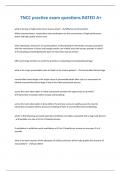
TNCC practice exam questions RATED A+
what is the key to high performance trauma team? - effective communication skilled communication, cooperation and coordination are the cornerstones of high-performance teams and high-quality trauma care when obtaining a history for an injured patient, understanding the kinematic concepts associated with the mechanism of injury and energy transfer can initially assist the trauma provider in what? - evaluating and anticipating the types of injury that may be present MOI and energy transfer c...
- Exam (elaborations)
- • 4 pages •
what is the key to high performance trauma team? - effective communication skilled communication, cooperation and coordination are the cornerstones of high-performance teams and high-quality trauma care when obtaining a history for an injured patient, understanding the kinematic concepts associated with the mechanism of injury and energy transfer can initially assist the trauma provider in what? - evaluating and anticipating the types of injury that may be present MOI and energy transfer c...

TNCC Practice Exam with Rationale
What is the key to a high performing trauma team? - effective communication rationale: skilled communication, cooperation, and coordination are the cornerstones of high- performance teams and high-quality trauma care When obtaining a history for an injured patient, understanding the kinematic concepts associated with the mechanism of injury and energy transfer can initially assist the trauma provider in: - evaluating and anticipating the types of injuries that may be present rationale: mec...
- Exam (elaborations)
- • 4 pages •
What is the key to a high performing trauma team? - effective communication rationale: skilled communication, cooperation, and coordination are the cornerstones of high- performance teams and high-quality trauma care When obtaining a history for an injured patient, understanding the kinematic concepts associated with the mechanism of injury and energy transfer can initially assist the trauma provider in: - evaluating and anticipating the types of injuries that may be present rationale: mec...
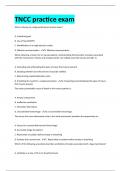
TNCC practice exam
What is the key to a high-performance trauma team? A. Individual goals B. Use of TeamSTEPPS C. Identification of a single decision maker D. Effective communication - D. Effective communication When obtaining a history for an injured patient, understanding the kinematic concepts associated with the mechanism of injury and energy transfer can initially assist the trauma provider in: A. Evaluating and anticipating the types of injury that may be present B. Deciding whether law enforcement s...
- Exam (elaborations)
- • 5 pages •
What is the key to a high-performance trauma team? A. Individual goals B. Use of TeamSTEPPS C. Identification of a single decision maker D. Effective communication - D. Effective communication When obtaining a history for an injured patient, understanding the kinematic concepts associated with the mechanism of injury and energy transfer can initially assist the trauma provider in: A. Evaluating and anticipating the types of injury that may be present B. Deciding whether law enforcement s...
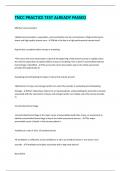
TNCC PRACTICE TEST ALREADY PASSED
Effective communication •Skilled communication, cooperation, and coordination are the cornerstones of high-performance teams and high-quality trauma care - What is the key to a high-performance trauma team? Reprioritize circulation before airway or breathing. •The across-the-room observation is done at the beginning of the primary survey to rapidly assess the need to reprioritize circulation before airway or breathing. This is done if uncontrolled external hemorrhage is identified - Th...
- Exam (elaborations)
- • 9 pages •
Effective communication •Skilled communication, cooperation, and coordination are the cornerstones of high-performance teams and high-quality trauma care - What is the key to a high-performance trauma team? Reprioritize circulation before airway or breathing. •The across-the-room observation is done at the beginning of the primary survey to rapidly assess the need to reprioritize circulation before airway or breathing. This is done if uncontrolled external hemorrhage is identified - Th...
